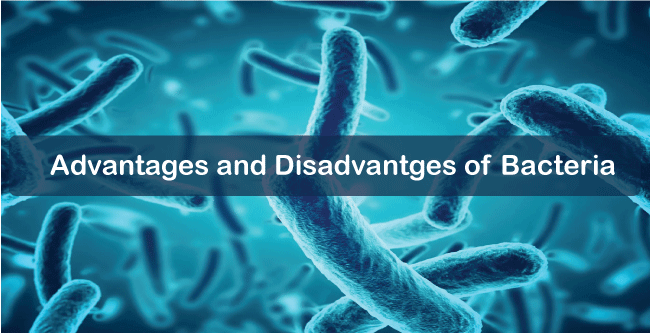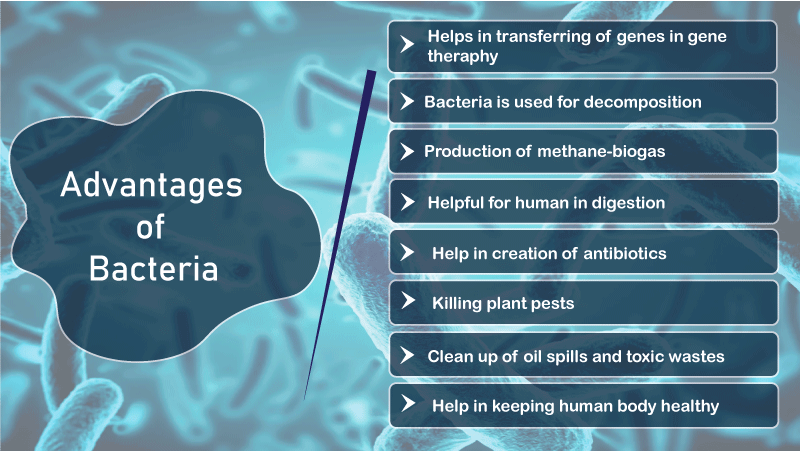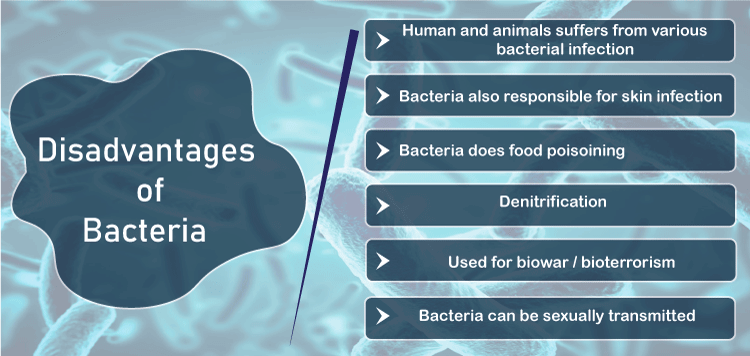Advantages and Disadvantages of Bacteria
All living organisms are made up of cells that can be unicellular (single cell) or multicellular (many cells). The basic building blocks of a body are cells that also convert food into energy and nutrient for the body. "Cells" - smallest unit of life without which life is impossible for living beings. These are in different shapes and sizes and have various components that perform multiple functions in an organism. Various microorganisms and organisms have multiple cells defined as multicellular such as living organisms (humans, animals, etc.), and some are made up of single cells defined as unicellular organisms, such as euglena, amoeba, planktons, bacteria, paramecium, diatoms, etc. Bacteria is one of the simple, single-celled organisms that are invisible to the naked eye, inside and outside of the organism, including humans. Bacteria can be present anywhere, whether it's substances and surfaces (soil, food, and water), where they act as critical players in the ecosystem. According to NHGRI - National Human Genome Research Institute, bacteria are of two kinds some are harmful (infectious to humans), and some are harmless (helpful to humans as they are required by the human body to perform certain functions like digestion. Some bacteria live in the digestive system). According to microbiology society, "bacteria are single-celled, tiny or micro-living organisms found anywhere on the earth or any surfaces including the human body, water, soil, solid substance, animals, material or many other things which can be dangerous or sometimes beneficial which cannot be seen from the naked eye." As a coin has two faces same as bacteria nature which sometimes can be dangerous and occasionally helpful as all bacteria are different rather than millions (various types) of bacteria found worldwide. Bacteria are classified based on their basic shape that can be present in pairs, single cells, chains, or clusters such as:
Yet bacteria are unicellular organisms, not having a nucleus or other membrane-bound organelles, due to which they are called prokaryotes. Bacteria are present in many shapes and sizes, consisting of these parts (body parts).
Types of bacteriaDifferent criteria on which bacteria can be classified are mostly accepted. These are the following: According to the oxygen requirement
According to the shape of the organism
According to the types of staining in microbiology
According to the temperature requirement for growth
According to the source of nutrient
Advantages of bacteria
a. It helps in transferring genes in gene therapy Bacteria are considered a vector in autofiction-based gene therapy as they carry the plasmid-based gene to the new host cell. b. Bacteria are used for decomposition. Bacteria act as a lion in the decomposition as it plays a vital role in degrading organic materials. The process of decay is invalid without bacteria. When moisture levels are high at the early stages of decomposition, bacteria decompose animal waste, dead organisms, and plant litter to obtain nutrients. Aerobic bacteria act as chemical decomposers in a compost pile. Billions of aerobic bacteria decompose the organic matter by warming up the compost pile (as they give off heat). c. Production of methane-biogas Bacteria named methanogens are capable of producing methane gas. These are archaea bacteria that produce gas as a metabolic by-product. Methane-producing bacteria are names methanosarcina, methanobacterium, methanospirilium, and echinococcus. These bacteria are present in sewage, sludge, mud, and in the rumen of animals. The sludge is broken down to produce methane gas (in strictly anaerobic conditions by intestinal methanogens), used as fuel for various activities. d. Helpful for humans in digestion Some good bacteria exist in the human body (colonized by 1014 microbes, ten times more than human cells) that play an essential role in digestion. These gut bacteria consist of lamia prepared, epithelial cells, and muscularis mucosae as a critical component of the microbiota ecosystem. These bacteria supply essential nutrients, aiding cellulose digestion, synthesizing vitamin K, and promoting angiogenesis and enteric nerve function. Bacteria like Lactobacillus are used in making healthy food like cheese and yogurt. These E. coli bacteria are present in the colon, which breakdown the complex carbohydrate using enzymes like polysaccharide lyases to a fermentable form. e. Help in the creation of antibiotics. Some bacteria are responsible for infection in humans and animals, and some antibiotics are used to cure them. Bacteria produce these antibiotics to kill harmful bacteria by stopping them from growing and multiplying. For the first time, the antibiotic was discovered from a single genus of bacteria called Streptomyces. It was the "golden age" of antibiotic discovery penicillin was found from 1945-1955 by a fungus with chloramphenicol, streptomycin, and tetracycline. f. Killing plant pests Pesticides kill pests, insects, rodents, or plants, which negatively affect agricultural land and cause diseases like typhus and malaria. The microbial insecticide named bacillus thuringinensis is a bacterium used to kill insect pests. It produces endotoxins during sporulation having specific toxicity to several insect species. g. Clean up oil spills and toxic wastes. The bioremediation process that uses bacteria to clean oil spills and toxic waste can be done by naturally occurring hydrocarbon-degrading bacteria. It breaks down the oil in the event of a fall, and some bacteria like marinobacter and alcanivorax have been isolated for this purpose. These are also named oil-eating microbes that clean up seafloor sediments contaminated by an oil spill. In seaborn oil, these oil-eating microbes break down the ring structures of hydrocarbon using enzymes and oxygen in the seawater. h. Help in keeping the human body healthy. With infectious bacteria and some healthy bacteria, probiotics help us keep our bodies healthy and well-functional. Good bacteria fight off harmful bacteria, absorb nutrients, and break down our food, which provides energy. Some beneficial, healthy bacteria are: Probiotic bacterial strains: bifidobacterium and Lactobacillus Disadvantages of bacteria
a. Humans and animals suffer from various bacterial infection Some bacteria present in the human or animal body, outer or internal, may cause infections. Here are some bacterial infections on the body and their symptoms: ear infection, sinusitis, whooping cough, strep throat, UTI, bacterial meningitis, BV, tetanus, salmonella, pneumonia, etc.
b. Bacteria are also responsible for skin infections. Certain skin infections happen due to bacteria such as:
c. Bacteria does food poisoning. Presence of bacteria (like salmonella enteritis, Clostridium botulinum, and staphylococcus aureus) in food cause food poisoning. Due to food poisoning, a human can have nausea, abdominal discomfort, vomiting, and even death. d. Denitrification Most bacteria decompose nitrogen compounds into free nitrogen, known as denitrifying bacteria, and the process is called denitrification. e. Used for Bioware/ bioterrorism Some infective bacteria act as bioweapons used in bioterrorism as an agent of adequate weapons. Bacillusanthracis, an antibiotic-resistant microorganism, is produced at a large scale for Bioware. These bacteria are released at strategic locations where they cause acute infection of anthrax and plague. f. Bacteria can be sexually transmitted. WHO (world health organization) states that more than 30 types of parasites, bacteria, and viruses can be passed through sexual contact, which is the reason for various sexually transmitted infections. Three common bacteria-based STIs named syphilis, chlamydia, and gonorrhea were cured with antibiotics. Bacterial STI's symptoms are a burning sensation during urination, bleeding between periods, unusual penile or vaginal discharge, sores around the mouth, anus, or genitals, painful bowel movements, and anal discharge or bleeding. Conclusion:With these advantages and disadvantages of bacteria, we can conclude that bacteria lie in every part of our life (surrounding, body, food, etc.). Bacteria have an expansive world and numerous varieties that still need to be discovered. Many diseases, like typhoid, cholera, food poisoning, etc., are caused by harmful bacteria but are also cured by antibiotics made from good bacteria. Several microbes live harmoniously with human cells in the human body, and their imbalance leads to disease and infection. This can weaken the immune system in the body. Bacteria are a part of the existence and survival of living and non-living things.
Next TopicHow to Create an EPF Online Account
|
 For Videos Join Our Youtube Channel: Join Now
For Videos Join Our Youtube Channel: Join Now
Feedback
- Send your Feedback to [email protected]
Help Others, Please Share










